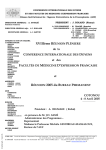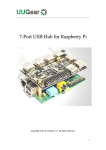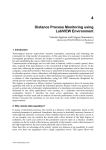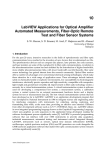Download An Opencores /Opensource Based Embedded System-on
Transcript
7 An Opencores /Opensource Based Embedded System-on-Chip Platform for Voice over Internet Sabrina Titri, Nouma Izeboudjen, Fatiha Louiz, Mohamed Bakiri, Faroudja Abid, Dalila Lazib and Leila Sahli Centre de Developpement des Technologies Avancées Lotissement 20 Aout 1956 Baba Hassen, Algiers Algeria 1. Introduction Today, with the explosion of the IP network protocol, communication traffic is mainly dominated by data traffic, unlike in the past it was dominated by telephony driven voice. This phenomenon has lead to the emergence of voice over data (VOIP) equipment that can carry voice, data and also video on a single network. The idea behind VOIP is to use the IP network for voice services as an alternative to the public switched telecommunication network (PSTN). The advantages over traditional telephony include: lower costs per call, especially for long distance calls, and lower infrastructure cost compared to the PSTN. The market for VOIP equipment has increased dramatically and a lot of solutions are proposed to the research and industry communities. Each specialised paper that appears shows that VOIP has an important place in the telephony market, especially in enterprise and public domain areas. The main challenges in designing a VOIP application are the quality of service (QoS), the capacity of the gateways and real time computation. Factors affecting the QoS are line noise, echo cancellation, the voice coder used, the talker overlap and the Jitter factor. The capacity of the gateway is related to the number of lines that can be supported in an enterprise environment. An integrated hardware-software development environment is needed to deal with real time computation. (Dhir, 2001). Most important VOIP solutions proposed in the market are based on the use of a general purpose processor and a DSP circuit. In these solutions, parts of the application run on software on the general purpose processor and the other part of the application runs on the dedicated DSP hardware to meet some performances requirements. Recently, and with the advance of the microelectronic technology in one hand, and CAD tools in the other hand, it is possible to integrate a whole system into a single integrated FPGA chip. Ended, FPGAs have evolved in an evolutionary and revolutionary way. The evolution process has allowed faster and bigger FPGAs, better CAD tools and better technical support. The revolution process concerns the introduction of high performances multipliers, Microprocessors and DSP functions inside the FPGA circuit. Thus, a new field which integrates VOIP solutions into FPGAs based System on Chip (SoC) is emerging, particularly the field of embedded VOIP based FPGA platform. Contrarily to DSP and general purpose processors, FPGAs enable rapid, cost-effective product development cycles in an environment where target markets are constantly shifting and standards continuously evolving. Most of these offer processing capabilities, a www.intechopen.com 146 VoIP Technologies programmable fabric, memory, peripheral devices, and connectivity to bring data into and out of the FPGA. Several approaches have emerged from industrial and academic research to design embedded systems into FPGA, such as the Xilinx approach which uses the Microblase processor (micro ), the Altera (Altera) approach which is based on the use of the Nios processor, the IBM approach which uses the Power PC processor and the Opencores approach which uses the OpenRisc processor (Opencores). Each approach tries to promote its processor in the market. In this paper, we propose a SoC platform for VoIP application. This last one is composed of two parts: a software part which is related to configuration of the VOIP application and which is based on the Opensource Asterisk-PBX platform (Maeggelen & al.,2007) and a hardware part related to the VOIP Gateway and which is used to connect the traditional PSTN network to the Internet Network. We concentrate on the VIRTEX-5 FPGAs family from Xilinx to build the embedded SOC hardware. The final goal is to implement an embedded VOIP system and where part of Asterisk PBX software is embedded into FPGA. Due to the complexity of the system, we planed to achieve our objective in three phases: • Phase1: Implementation of a simple VOIP application based on Asterisk and a commercial Digium TDM card. • Phase2: Replace the Digium card and build a new VOIP Gateway based on FPGA and using the OpenRisc processor; • Phase3: Build an embedded Asterisk into the proposed VOIP based FPGA Gateway. The originality of our approach is the adoption of the OpenCores and Opensource concepts for the design and implementation of the whole SOC VOIP platform. With analogy to Opensource-Linux, Opencores is a new design concept which is based on publishing all necessary information about the hardware. The design specifications, hardware description language (HDL) at Register Transfer Level (RTL), simulation test benches, interfaces to other systems are documented. Usually, all this information is not available for free without any restriction. This new design concept is proposed as a bridge for the technological, educational and cultural gaps between developing and developed countries. The benefit of using such methodology is flexibility; reuse, rapid SoC prototyping into FPGA or ASIC and the entire software and hardware components of the VOIP application are available at free cost. This can also reduces the whole VOIP cost. In section 2, general presentation of Voice over IP is given. Section 3 deals with presentation of the Opencores development platform. In section 4, presentation of the proposed VOIP Gateway architecture is given. Simulation and synthesis results are given in section 5. Followed by, presentation of the implementation results. In section 7 the PCB of the proposed SOC architecture is presented, followed by the presentation of the documentation phase; and finally, a conclusion. 2. General presentation of voice over IP Voice over IP had its starts in February 1995 when a manufacturer started marketing software that enabled a conventional computer equipped with a sound card, microphone and loudspeaker to phone another PC via the internet. Initially, the voice quality achieved was unsatisfactory but the principle behind it drew a great attention of public, thus the first area of application for VoIP: PC-to-PC was established. Subsequent to this introduction a number of manufacturers concentrated on developing similar software and consequently raised the question of compatibility among different systems. In 1996, the International www.intechopen.com An Opencores /Opensource Based Embedded System-on-Chip Platform for Voice over Internet 147 Telecommunication Union (ITU-T),(ITU, 2007) responded by developing the H.323 standard. Afterwards, the focus was the possibility of placing long distance calls using voice over IP known as toll bypass; however this required setting up a connection between the telephone network (PSTN) and the data network, a task performed by the so called Gateways. The result has been additional application for VoIP including: PC-to-phone, Phone-to-PC and, when two gateways are used, Phone- to - phone communication is established. This last option was the catalyst in the establishment of a new provider group named ITSP (Internet Telephone Service Provider) that permits telephony over IP within the provider network using prepaid cards. To date, VoIP refers to the ability to transfer data and voice and also video on the single network. Figure 1 illustrates the basic operating principle of VoIP. The human voice initially generates an analog signal. This signal is converted into a bit stream by an Analog/ Digital (A/ D) converter. And then submitted to a multiple compression process. The Voice frames are integrated into a voice packet. First RTP (Real time protocol) packet with a 12 address byte header is created. Then an 8-byte UDP packet with the source and destination address is added. Finally, a 20 byte IP header containing source and destination gateway IP address is added.The packet is sent through the internet where routers ands switches examine the destination address. When the destination receives the packet, the packet goes through the reverse process for playback. A minimal VoIP implementation requires two functionalities. First, it should be able to connect to other VoIP phones and, second, voice data should be carried by the Internet. The first requirement is fulfilled by using signaling. The second one is achieved by using speech coding algorithms. 2.1 VOIP signaling Signaling enables individual network devices to communicate with one another. Both PSTN and VoIP networks rely on signaling to activate and coordinate the various components needed to complete a call. In a PSTN network, phones communicate with a time-division multiplexed (TDM) Class 5 switch or traditional digital private branch exchange (PBX) for call connection and call routing purposes. In a VoIP network, the VoIP components communicate with one another by exchanging IP datagram messages. The format of these messages may be dictated by any of several standard protocols. The most commonly used signaling protocols –Session Initiation Protocol (SIP), H.323 and Media Gateway Control Protocol (MGCP). In this paper interest is given to the SIP protocol (Rosenberg & al, 2002). 2.1.1 Session Initiation Protocol (SIP) SIP is a signalling protocol for initiating, managing and terminating sessions across packet networks. These sessions include Internet telephone calls, multimedia distribution, instant messaging, and multimedia conferences. SIP invitations are used to create session that allows participants to agree on a set of compatible media types. SIP makes use of elements called proxy servers to help route requests to the user’s current location, authenticate and authorize users for services, implement provider call-routing policies, and provide features to users. SIP also provides a registration function that allows users to upload their current locations for use by proxy servers. SIP clients are referred to a SIP User Agents, and may make peer-to-peer calls, though usually they register and setup sessions via a SIP proxy. SIP can run on top of several different transport protocols though it most commonly uses UDP over Internet Protocol. Figure 2 shows the SIP session establishment. www.intechopen.com 148 VoIP Technologies A/D Converter Echo suppression IP Compression G.7xx UDP RTP G.7xx IP Network LAN, WAN De-copression D/A Converter Fig. 1. Principle of VoIP SIP/SDP INVITE SIP 100 Trying SIP 180 Ringing SIP/SDP 200 ok SIP ACK 1 4 2 3 5 6 7 8 9 8 # * 1 4 2 5 3 6 7 * 8 8 9 # RTP Stream SIP BYE SIP 200 Ok Fig. 2. SIP Session Establishment 2.2 Speech coding algorithm The speech coding allows the reduction of transmission speech signal and communication channels to a limited bandwidth. The bandwidth of a transmission must be minimized while maintaining the quality of the voice signal. Most codecs are algorithms, used to reduce the bit rate of speech data incredibly, while maintaining the voice quality. The most commonly used codecs in VOIP systems are: G.711 PCM, G.726 (Chen, 1990)ADPCM , G.729 LD-CELP (ITU-T, 1996), and G. 729/ G.729a CS-ACELP (Salami & al, 1998). PCM and ADPCM belong to the family of so called waveform codecs. These codecs simply analyze the input signal without any knowledge of the source. Most of these codecs work in time domain, like PCM. These codecs offer high quality speech at a low computational complexity. But if we try to get the bit rate below 16 kbps the quality decreases tremendously. www.intechopen.com 149 An Opencores /Opensource Based Embedded System-on-Chip Platform for Voice over Internet Coding algorithm Bandwith (Kbps) Algorithmic Delay (ms) Complexity (MIPS) MOS G.711 PCM 64 0.125 0 4.3 G.726 ADPCM 16-40 0.125 6.5 2.0-4.3 G.728 LD-CELP 16 0.625 37.5 4.1 G7.29 CSACELP 8 10 17 3.4 Table1. Characteristics of the most coding algorithms To get the bit rate really down another approach is necessary. Source coders need to know the characteristics about the input being coded. Out of these characteristics a model of the source is made. When an input is encoded the source coder tries to extract the exact parameters of this model from the input. Then these parameters and a two state excitation is transmitted. These codecs can simply transport the pure informational content of a speech sample and not the voice itself. Their big advantage is that they operate with bit rates as low as 2.4 kbit/ s. Hybrid codecs try to combine the advantages of waveform codecs, which is good quality, with the advantages of the source codecs that is low bit rate. To get the best excitation signal all possible waveforms are tested and the one with the least error is then chosen. This involves a very high computational complexity for every analysis frame. The low bit rate codecs usually involve a high computational complexity and a delay and the waveform codecs have the advantage of low delay and excellent quality. In Table 1 there is an overview of the quality of the most common codecs according to the Mean Opinion Score (MOS). This score is derived from a large number of listeners who rated the quality of the played sample with a score from excellent (5) to bad (1). It should be understood that the various coding methods vary in the levels of complexity, delay characteristics and quality. The evaluation of speech quality is of critical importance in any VOIP application, mainly because quality is a key determinant of customer satisfaction. Traditionally, the only way to measure the perception of quality of a speech signal was through the use of subjective testing, i.e., a group of qualified listeners are asked to score the speech they just heard according to a scale from 1 to 5. This is most reliable method of speech quality assessment but it is highly unsuitable for online monitoring applications and is also very expensive and time consuming. Due to these reasons, models were developed to identify audible distortions through an objective process based on human perception. Objective methods can be implemented by computer programs and can be used in real time monitoring of speech quality. Algorithms for objective measurement of speech quality assessment have been implemented and the International Telecommunications Union has promulgated ITU-T P.862 standard (ITU, 2001), also known as Perceptual Evaluation of Speech Quality (PESQ), as its state of-the-art algorithm. 2.3 Presentation of asterisk Asterisk is a complete IP PBX (Meggelen & al., 2007) in software. It runs on a wide variety of operating systems including Linux, Mac OS X, OpenBSD, FreeBSD and Sun Solaris and provides all of the features expect from a PBX including many advanced features that are often associated with high end (and high cost) proprietary PBXs. Asterisk supports Voice over IP in many protocols (SIP, H323, ADSI, MGCP, IAX), and can interoperate with almost all standards-based telephony equipment using relatively inexpensive hardware. Asterisk is released as open source under the GNU General Public License (GPL), meaning that it is www.intechopen.com 150 VoIP Technologies available for download free of charge. Figure 3 shows different modules involved during routing an IP network to a PSTN one. Asterisk’s core contains several engines that plays a critical role in the software. When asterisk is first started, the Dynamic Modular Loader loads and initializes each of the drivers which provide channel drivers, file formats, call detail record back-ends, codecs, applications and more, linking them with the appropriate internals APIs. Then Asterisk’PBX Switching Core begins accepting calls from interfaces and handling then according to the dialplan, using the Application Launcher for ringing phones, connecting to voicemail, dialing out outbound trunks, etc. The core also provides a standard Scheduler and I/ OManager that applications and drivers can take advantage of Asterisk's Codec Translator permits channels which are compressed with different codes to seamlessly talk to one another. Most of of Asterisk’s usefulness and flexibility come from the applications, codecs, channel drivers, file formats, and more which plug into Asterisk’s various programming interfaces. Asterisk Gateway Interface (AGI) Asterisk Management Interface (AMI) Paging Dialing Directory Voicemail Calling Card Conferencing Custom applications Asterisk Application API Codec Translator Codec Translato r API Application Launcher CDR Core Mu-law Linear G.729 A-law GSM ADPCM Speex Scheduler and I/O Manager PBX Switching Core Dynamic Module Loader Asterisk File Format API GSMsf .wav G729 G.711 H.263 Asterisl Channel API IAX SIP H.323 MGCP Custom Hadware ISDN CISCO Skinny UniSTM T1 Fig. 3. Asterisk modules card To provide call management, operation of Asterisk is reflected by a set of configuration files. The first configuration step is the definition of the user accounts and terminals. These are identified by the signalling protocol they use. We note particularly the file “ sip.conf” which contains the parameters related to the SIP protocol. The first part is useful for the general options of SIP as the address IP and the corresponding port. The following part define the parameters of the client such the number of the user, his password, IP address, list of codecs allowed by the user, etc.Once the user account and terminal defined, we must assign phone www.intechopen.com An Opencores /Opensource Based Embedded System-on-Chip Platform for Voice over Internet 151 numbers so that they are reachable, we must also determine the procedure which will hook on each call as well as the special services that we want to activate. This is done by dial numbering plan. This last one is the centrepiece of the configuration of the asterisk server. This dial plan contains all the intelligence and logic operation of a telephone network. It consists of a set of rules structured in a single file named “ extension.conf”. The content of “extensions .conf” is organised in sections which can be either for static setting and definitions or for executable dial plan component in which case they are referred to as “ contexts” . 3. Presentation of the Opencores system on chip development platform Using the OpenCores design methodology, we have developed our own SoC platform for VOIP applications (Titri & al., 2007),(Abid & al., 2009). Figure 4 gives an overview of the whole platform. Parent Directory Embedded SOC Project 1 Embedded SOC Project 2 Embedded SOC Project N Embedded SOC Project Project Documentation PCB Layout Softawre Hardware Coding HDL Application.c Reset.s GNU Binutils GCC Ld Linker RAM.ld Compiling Application.o Makefile for Synthesys OpenCores IP library Makefile for Simulation Linker Application.or32 GDB OR1KSim (sim.cfg) Debug on OR1KSim Convert & Download Soft Application to memory Board Software Part of the Platform Synthesys Tool Simulator Tool Place & Root Tool Bit Stream Generation Hardware Part of the Platform Fig. 4. Platform architecture Creation of the platform begin by creating a library which is composed of the Wishbone interconnect standard bus, the OR1200 processor and other public cores suited for VOIP purposes such as the audio and video codec’s, the MAC/ Ethernet, the USB, the UART, memories, etc. In this library, all the cores are reusable and are described in the VERILOG language. As shown in figure 4, at a high level, a SoC designer specifies the Software and the hardware part of the project. In a SoC, software and hardware are related to each other by the RTOS (Real Time Operating System). After defining the architecture, different phases www.intechopen.com 152 VoIP Technologies can be achieved in parallel: the simulation, the synthesis, the PCB layout and the project documentation phases. 3.1 Presentation of the hardware part of the platform After defining the architecture, different phases can be achieved in parallel. First, we start by downloading from the opencores web site IP cores that constitute the architecture of the embedded SOC project. Figure 5 shows the structured embedded SOC project directories. • Lib: is a directory which contains all the IP cores ; • RTL: is a directory which contains the source files of all IPs described in Verilog RTL (Register Transfer Level) which can be modified in the top level ; • Bench: is a directory which contains test bench for all IPs core ; • DOC: is a directory which contains the specifications and design manual relating to each IPs core ; • And finally a CVS (Concurrent Version Check) which is a directory who is automatically created when running the CVS. The Version control system software keeps track of all work and all changes in a set of files, and allows several developers (potentially widely separated in space and/ or time) to collaborate each other. The repository stores a complete copy of all the files and directories which are under version. Em b edded SOC Pr oject CVS CVS RTL DOC Bench Lib HDL V er ilog IPs Specification Sim IPs IP 1 IP 2 IP N CVS stim uli Fig. 5. The structured embedded SOC project directories Once the HDL files of the architecture is downloaded and stored in the repository, the simulation and synthsis, the PCB layout and the project documentation phases can be achieved. Simulation and synthesis are done using the ISE design tool (ISE ) and ModelSim simulator (ModelSim) respectively . These tools are executed at the back end plan of the platform. By using the Make language, a Makefile is created for simulation and another one for synthesis. These files contains the path/ directory of the IP cores which are stocked in the library and the synthesis or simulations options (such as target FPGA device, surface/ timing constraints, specific input/ output, etc.). Figures 6 and 7 show respectively the contents of the makefile and its arborescence. Thus, for each SoC architecture the Makefile is created once. With this way, a designer concentrate only in his design to avoid errors due to fault manipulation of the tools options, www.intechopen.com An Opencores /Opensource Based Embedded System-on-Chip Platform for Voice over Internet 153 DESIGN = Projet_SOC PINS = Projet_Soc_top.ucf DEVICE = xc5vlx50-2ff1153 SRC = VOIP_soc_top.v tc_top.v # IP Debug interface SRC+= dbg_interface/ dbg_top.v \ dbg_interface/ dbg_sync_clk1_clk2.v \ dbg_interface/ dbg_registers.v \ dbg_interface/ dbg_crc8_d1.v \ # IP Processor SRC += or1200/ or1200_top.v or1200/ or1200.v or1200/ or1200_wb_biu.v or1200/ or1200_immu_top.v or1200/ or1200_ic_top.v or1200/ or1200_cpu.v \ or1200/ or1200_dmmu_top.v or1200/ or1200_dc_top.v # IP Memory SRC+= mem_if/ onchip_ram_top.v mem_if/ onchip_ram.v ... Fig. 6. Contents of the Makefile Makefile CVS RTL HDL Verilog CVS OR1200 UART Debug SOC-ProjetTOP.V XILINX ISE ModelSim Synthèse Place & root Tool Download to Board Fig. 7. Structured Makefile hence the design time and further the time to market factor are reduced. The PCB layout is done using the ORCAD capture Ver9.6 tool. It is recommended to begin the PCB layout and the project documentation early in the design process to allow different members of a team working in the same project communicate and co-operate with each other. For example, each time a change is made within an IP or a new version is created, it is communicated to the PCB and documentation teams and vice-versa. This is done through the use of a CVS. www.intechopen.com 154 VoIP Technologies 3.2 Presentation of the software part of the platform The software part includes a set of development tools, all of them ported from GNU toolchain and an Architectural simulator OR1KSim developed by the Openrisc project team (Bennett 1,2008),(Bennett 2, 2008). The GNU toolchain consist of a GCC, GNU Binutils and GDB. In our project, the GNU Toolchains are used to compile, link programs, and generate the binary file. The Architectural simulator OR1KSim is a stand-alone C program which emulates the instruction set and behavior of an OR1200 processor OR1K. The simulator has also been expanded to include simulations of many OpenCores peripherals, including serial ports, memory controllers, etc. The simulator may be used to develop software for the target platform before the hardware becomes available or fully verified. This will allow the user to separate debugging of the hardware and software, rather than having to run untested software on uncertain hardware. As shown in figure 8, the first step consists on developing a C program “ application.c” , this file implements the main functions needed for the VOIP application. Application.c GNU Toolchain Compiler Applicaltion.o Or32-uclinux-as Linker Or32-uclinux-ld Assembler Or32-uclinux-nm Classified Application.or32 OR1KSim Sim.cfg Debug on OR1KSim Convert & Download to board Fig. 8. Software flow of the platform In the next step, the GCC tool is used to compile the program, in this phase the object file “ application.o” is generated, in order to be used by the linker (ld linker). This file is linked with the linker file (ram.ld) which is used to map all the instructions, variables, data and stacks to the corresponding address in the memory. The resulting binary file “ application.or32” is used with the configuration file “ sim.cfg” in the debug on or1ksim step. The “ sim.cfg” file contains the default configurations of peripherals and a set of simulation environments which are similar to the actual hardware situation. In this phase the or1ksim simulator and the GDB tools are invoked. Finally the binary file “ application.or32” is converted to the memory initialization file and downloaded into the on-chip RAM configured in sim.cfg. 4. Presentation of the general VOIP architecture Figure 9 illustrates the proposed SOC Platform architecture for VOIP application. This last one is composed of two parts : A software part which is related to configuration of the VOIP application and which is based on the Opensource Asterisk-PBX platform and a hardware www.intechopen.com An Opencores /Opensource Based Embedded System-on-Chip Platform for Voice over Internet 155 part related to the VOIP Gateway and which is used to connect the traditional PSTN network to the internet Network. We concentrate on the VIRTEX-5 FPGAs family from Xilinx to build the embedded SOC architecture. VOIP Application PC Test PC Admin Server Asterisk VOIP SIP, H323 VOIP SIP, H323 PC + Softphone PC + softphone VOIP Gateway Analog phone Analog phone (Hardware Part) Fax Cell phone Fig. 9. Architecture of the VOIP application 4.1 Presentation of the software part The software part of the application contains the following elements: • A VOIP Asterisk server under Linux environment. • An administrators "admin" under Windows environment to manage the system. • A computer with a "softphone" under Windows to establish communications. The choice of Windows is justified by the simplicity of use and its convivial interface for the customer. • Thanks to Ethreal (Eth, 2006) software which analyze the performance of the application on the VOIP network. • An analogic phone in the case of the PC to phone and phone to phone application. • A fax if one wants to send fax via internet protocol. 4.2 Presentation of the hardware part Concerning the hardware part, we have developed an OpenRisc based SOC architecture that includes a 32 bits RISC processor core and a set of elements needed to provide a VOIP functionality, an OR1K debug system for debugging purpose, a memory controller that controls an external Flash and SDRAM memory, an Universal Asynchronous Receiver Transmitter (UART), an Audio codec for Voice coding, a standard Ethernet that transmit voice packets over The internet and an internal boot memory. All the cores are connected through the WISHBONE bus interface. We created a SOC verilog description for the integration of all the IP cores. The proposed VOIP gateway architecture is depicted in figure below. www.intechopen.com 156 UART 16550 Open Risc 1200 CPU W I S H B O N E OR1K Debug System JTAG Physic Interface Audio Serial Interface Audio Codec Memory Controller ROM Boot Flash SDRAM 10/100 MAC Ethernet RS 232 VoIP Technologies Fig. 10. VOIP gateway architecture 4.2.1 The WHISHBONE bus Interface The WHISHBONE interconnect is a portable and flexible interface for use with semi conductor chips. It defines a common, logical interface between sections of the chip and allows them to communicate better. These sections known as “ cores” can be developed and tested independently and later combined to form a complete system on chip. Currently WISHBONE is the only SoC specification in the public domain (Wishbone,2004). All other methodologies such the IBM Core Connect (IBM) bus and the AMBA Bus (AMBA) are proprietary. Figures 11 and 12, show the structure of the WISHBONE bus. The WISHBONE uses a master/ slave architecture. That means that functional modules with MASTER interfaces initiate data transactions to participating SLAVE interfaces. As shown in Figure 12, the master and slave communicate through an interconnection interface. Some signals are specific to the master core, others to the slave one and there are common signals shared between the master and the slave. the WHISHBONE bus can be configured in different ways depending on the application. 4.2.2 The OR1200 Processor We use the OR1200 (Lampret, 2001), a publicly available processor for our development of SoC VOIP Gateway. This soft-core is freely distributed under an GPL license at OpenCores website, and fits for composition SoC in many ways. OpenRISC 1200, synthesizable core, is implemented with Verilog HDL, and has high flexibility because all configuration options for the processor are gathered together into a single file containing numerous define statements. A block diagram of the OR1200 architecture is depicted in Figure 13. www.intechopen.com An Opencores /Opensource Based Embedded System-on-Chip Platform for Voice over Internet 157 Fig. 11. Wishbone interconnection Wishbone Bus M0 S0 S1 M2 S2 M4 MASTER I/F M3 SLAVE I/F M1 S3 S4 M5 S5 M6 S6 M7 S7 Fig. 12. Wishbone configuration The OR1200 core is a 32-bit scalar RISC with Harvard micro-architecture, 5 stage integer pipeline, virtual memory support (MMU) and basic DSP capabilities. It includes a debug www.intechopen.com 158 VoIP Technologies unit for real-time debugging, high resolution tick timer, programmable interrupt controller and power management support. OR1200 runs at 33 MHz on a Virtex FPGA. The OR1200 communicates with the WISHBONE interconnect (WBI). Documentation about the OR1K, HDL code and OR1K simulator under Linux and other tools for software debugging is available for free download. In our application we use the OR1200 processor, as it is well documented. PM I/F Power DB I/F Debug Tick Timer INT I/F IMM Icache 8KB CPU PIC Dcache 8KB W B I W B I DMMU Fig. 13. The OpenRISC 1200 architecture 4.2.3 The OR1K debug system The OR1K debug system (Yawn, 2009) allows controlling and observing the execution of the software running under the OR1200 processor. It acts as an interface between the host and the target system (SOC), communicating directly to the Openrisc 1200 CPU and the WishBone bus. Figure 14 shows the different modules involved in the OR1K debug system. These are: the “ Advanced debug Interface” core (adv_dbg_if), the “ JTAG TAP” core and the “ Xilinx internal JTAG”. The “ adv_dbg_if” core controls transactions to the CPU and the WishBone bus, and provides clock domain synchronization between the CPU, the WishBone, and the JTAG TAP. The “ JTAG TAP” is used to connect directly with external debugger (software or hardware). Specified by the standard boundary scan IEEE 1149.1, It is accessed by four (or five) external pins, and includes mainly two main registers for instruction and data loading (IR and DR). This JTAG TAP is suitable for use in ASICs and all FPGAs. The Xilinx Internal JTAG core is used only when the system is implemented in a Xilinx FPGA which supports a BSCAN_* macro block (e.g. BSCAN_SPARTAN3, BSCAN_VIRTEX4, etc.). Fig. 14. The OR1K Debug System Architecture www.intechopen.com An Opencores /Opensource Based Embedded System-on-Chip Platform for Voice over Internet 159 4.2.4 The UART (Universal Asynchronous Receiver/Transmitter) The UART core (Universal Asynchronous Receiver/ Transmitter) from Opencores (Gorban, 2002), provides serial communication capabilities, which allow communication with a modem or other external devices, like another computer using a serial cable and a RS232 protocol. Figure 15 illustrates the overall architecture of the core. This core is designed to be maximally compatible with the industry standard National Semiconductors 16550A device. Fig. 15. The UART Architecture and the other one is used to transmit or receive data from the UART port. All the data operations are FIFO (First In, First Out) and it requires one interrupt, 2 pads in the chip (serial in and serial out) and optionally another six modem Status/ control signals. The Baud Rate Generator is a programmable Transmit and Receive bit timing device. Given the programmed value; it generates a periodic pulse, which determines the baud rate of the UART transmission. The transmitter module convertes the parallel data into serial form, the receiver unit process the serial data received from the RS232. 4.2.5 The memory controller The memory controller (Usselman,2002) supports a variety of memory devices; flexible timing and predefined system start up from a Flash or ROM memory. Figure 16 illustrates the overall architecture of the core. It consists of a 32 bit bus WISHBONE interface, a poweron configuration, a refresh controller, an open bank and row tracking, an address MUX and Counter, a data latch packet and parity, a memory timing controller a memory interface and a configuration and status register. 4.2.6 The MAC/Ethernet unit The Ethernet core (Mohor,2002) is a 10/ 100 Media Access Controller. It consists of synthesizable Verilog RTL core that provides all features necessary to implement the layer 2 protocol of the standard Ethernet. It is designed to run according to the IEEE 802.3 specification that defines the 10 Mbps and 100Mbps for Ethernet and Fast Ethernet applications respectively. In this work the Ethernet/ MAC allows Internet connection. Figure 17 shows the general architecture of the IP. www.intechopen.com 160 VoIP Technologies External IO Buffers Power-on Config Refresh Controller Config & Status Registers Memory Interface Memory Timing Controller Open Bank & Row Tracking Adress Mux & Conter Power Down Controller Data Latch Packer & Parity Wishbone IF Fig. 16. The Memory Controller Architecture MIIM (manag) Tx Module Wishbone Ethernet HOST I/F PHY Control Module Rx Module Fig. 17. The MAC Ethernet Architecture It consists of several building blocks: a Tx module an RX module, a control module, a management block and a WISHBONE interface. The TX and RX modules provide full transmission and reception functionality respectively. Cyclic Redundancy Check (CRC) generators are incorporated in both modules for error detection purposes. The control module provides full duplex flow control. The management module provides the standard IEEE 802.3 Media Independent Interface (MII) that defines the connection between the PHY and the link layer. Using this interface, the connected device can force PHY to run at 10 Mbps with frequency of 2.5 MHz versus 100 Mbps (25 MHz) or to configure it to run at full or half duplex mode. The WISHBONE interface connects the Ethernet core to the RISC and to external memory. To adapt this IPs to our application we have determined the specification required to the VoIP application. www.intechopen.com An Opencores /Opensource Based Embedded System-on-Chip Platform for Voice over Internet 161 4.2.7 The audio codec The Audio Codec core digitizes the analog voice from the headset, group data into packets and then transmits it across the network. Figure 18. shows the architecture of the G711. Coding G711 A Law Computing Segment PCM-in Computing Level in the segment Link with the output G711-out Decoding G711 A Law G711-in Input Standard Préparation for lag Lag PCM-out Fig. 18. Architecture of the G.711 We consider the G711 PCM, G726 ADPCM, G.728 LD-CELP and G729/ G729a CS-ACELP. The programs codes for different Codec’s are available free from ITU-T. They can easily adapted to our application. The two main encoding laws used nowadays are A law (a-law) and µ law (µ-law), that are also known as g.711 codec . A Law (a-law) is used mainly in European PCM systems , and the µ law is used in American PCM systems. 5. Simulation and synthesis results 5.1 Functional simulation Although, most of the HDL cores at RTL level, are available freely for simulation and synthesis from OpenCores, the most difficult task in designing the SoC hardware is how to write an HDL code that integrates all the SoC components codes and how these components communicate each other through the WISHBONE interface bus. To do this, the first step is to define the MASTER from the SLAVE components in the architecture. The OR1200 processor is set as a MASTER of all components. Considering the complexity of the gateway system and to avoid problems of debugging, we set the goal to simulate and validate the functionality of each IP using the ModelSim simulator tool. • Figure 19 shows the communication protocol between the processor OR1K, the bus Whishbone and different IPs. The processor is configured as "Master" and various IP As "Slave". • Figure 20 shows the functionality of the memory controller and SDRAM . • Figures 21 and 22 show the simulation results of the Transmission and Reception process of the 10/ 100 MAC/ Ethernet . • Figure 23 shows the simulation results of the encoder G711 . 5.2 Synthesis and implementation results Having validated the various applications of the SOC, we performed the synthesis and system implementation through the ISE Foundation tool 10.3i Xilinx. Figure 24 shows the layout of the VOIP SOC Gateway. The whole Architecture is mapped into the XC5VLX501FF676 FPGA circuit family. Mainly, the SoC occupies 60% of the FPGA surface in term of slice LUT, 27% of slices registers, 31 % of inputs/ output , 8% of integrated DSP48E. www.intechopen.com 162 Fig. 19. Wishbone simulation result Fig. 20. Memory Controller simulation results www.intechopen.com VoIP Technologies An Opencores /Opensource Based Embedded System-on-Chip Platform for Voice over Internet Fig. 21. MAC Ethernet Transmit simulation result www.intechopen.com 163 164 VoIP Technologies Fig. 22. MAC Ethernet Reception simulation result Fig. 23. G711 simulation result 6. Test results Due to the complexity of the system, we have adopted a strategy in order to achieve our goal, several steps are necessary in order to validate the embedded VOIP application. These are: (1) Test of the VOIP application using Asterisk, (2) Test of the proposed SOC gateway architecture, (3) Running Uclinux/ Asterisk under OR1Ksim to load and run the whole VOIP application. www.intechopen.com An Opencores /Opensource Based Embedded System-on-Chip Platform for Voice over Internet 165 Fig. 24. Layout of the VOIP SOC Gateway 6.1 Test of the VOIP application using Asterisk In this section, we have used a TDM Digium card TDM11B (Digium) as gateway to connect to Asterisk. Three applications tests are done in order to test the VOIP application: The first application is to test the network traffic. To do this, we have used the software Ethereal. Figure 25 represents the results obtained in the PC observer regarding the timing of a telephone call as follows: Signalling: The first three queries are repeated twice: the customer has not yet hanged up; Communication: as soon as the customer picks up the handset called his phone, a SIP message (200 OK) is sent to the server call: the customer has accepted the appeal request. In the same way, the call server sends a message SIP (200 OK) to the customer to inform him that the client accepted his appeal. The acquittal of the customer Fig. 25. Test of the network trafic www.intechopen.com 166 VoIP Technologies (Message: ACK SIP: [email protected]: 5060) has triggered the session between two clients. The role of SIP is completed successfully. He leaves his place for the following two steps namely coding and transmission of voice. The selected black frame shows the beginning of trade flow between the two RTP correspondents (voice packets encoded in the standard G711 standard of the International Telecommunication Union (ITU). End of the call: exchange SIP message: BYE. The second application is to test the hierarchy of different communication protocols involved in a VOIP application. Figure 26 shows the order of the various protocols in a VOIP call session, after analyzing the available statistics in the Ethereal program for each call made. Figure 26 shows that the first protocol involved in a communication VOIP is the SIP signalling protocol. The number of packets exchanged via SIP is eight. Thereafter, the encapsulation IP/ UDP/ RTP, to arrive at the Ethernet physical layer. The third application is to test the establishment of a call between two analogue phones via VoIP gateway. Figure 27 shows that communication is well established. Fig. 26. The hierarchy of protocols involved in the appeal Fig. 27. Call establishment 6.2 Test of the proposed SOC gateway architecture In this section the following tests are done: (1) Serial transfer test , (2) Boot Uclinux under OR1ksim, (3) Embedded network emulation and test.All these applications are done using the software part of the opencores development platform. The application of the serial transfer test in the FPGA is done through the GDB. The communication protocol between the host and the architecture implemented on FPGA is done through the JTAG Proxy Server. www.intechopen.com An Opencores /Opensource Based Embedded System-on-Chip Platform for Voice over Internet 167 GPRsRegisters Assembler Program JTAGproxy Server Load test file Reset test Program Execute program Fig. 28. Results of the serial transfer test Fig. 29. Boot of Uclinux under OR1ksim www.intechopen.com Fig. 30. FPGA board-PC Frame tansfer test result 168 VoIP Technologies Figure 28 summarize all the commands executed by the Display Data Debuger (DDD)which is the graphical interface of the GDB.Different windows are displayed ( application.c program window, assembler program window, contents of registers window and execution program window). The execution of these commands allows the debugger to display on the terminal the message “ HELLO WORLD” . The visualization of the "Hello World" message allowed us to validate the communication protocol between the processor and the UART. Figure 29 shows results of booting Uclinux under the OR1kSim simulator. To test the embedded network emulation, the Ethernet IP core is chosen as a network controller. The Ethernet frame from Ethreal is used to test the network application between FPGA board and PC. We used the serial port to visualize the frame transfer. Figure 30 shows the FPGA board-PC frame transfert test result. 6.3 Running Uclinux/Asterisk under OR1Ksim to load and run the whole VOIP application In this section, we aim to build a VOIP application in which Asterisk is embedded into the FPGA. The advantage of using such solution, is to realize a portable system while reducing power dissipation, chip interconnects and device size. Embedded Asterisk is state of the art design. To our best knowledge two works have been proposed. The first one is from Asterisk “ Astlinux” which provides an Asterisk installation on a linux distribution that has been build from scratch and optimized for small format of hardware format. The second one is from the OPSIS company (Koroneos, 2008) which is based on FPGA, and where the processor is Power PC instead of OpenRisc. The main advantage of our approach is that the software and the hardware involved in the design are all opensource, this reducing the coast of the VOIP application. Uclinux/Asterisk Ph ysic In te rfa ce Au d io Se ria l In te rfa ce RS 232 SD R AM On chip memory 10/100 MAC Ethernet Audio Codec UART 16550 Open Risc 1200 CPU W I S H B O N E OR1K Debug System JTAG Off chip FPGA memory Memo ry C ontroller Uclinux/Asterisk ROM Boot Fla sh Fig. 31. Embedded Asterisk into the FPGA 7. Prototyping Circuit Board (PCB) of the proposed SOC architecture To lead the project until its term, we planned to construct a prototype board using the Orcad CAD tool (ORCAD, 2004). Figure 32 shows the different steps involved in PCB design. Orcad gives the possibility to create electronics diagrams and trace the physical part of the www.intechopen.com An Opencores /Opensource Based Embedded System-on-Chip Platform for Voice over Internet 169 design (layout) starting from the footprints of the components. Internet is essentially used to retrieve technical documentation of the components. Capture-CIS is one of the many components which give the possibility to create electric diagrams. Digi-Key is an Internet provider of electronic components who is entirely compatible with Orcad. We have the possibility of configuring Orcad-CIS to access the database of components and suppliers of the site of Digi-key. This allows selection directly from the library of Digi-Key to insert a component in our diagram. The tool has a much expanded database in which it only remains to find the selected components. Despite such a database, it is possible that we will not find all the components because some may be very specific. In this case it is requested to produce its own library because most of the map items are too specific to be part of Orcad libraries and Digi-Key. Once the diagram is finished, we move to the checking of the electrical characteristics (Design Rules Check) of our scheme in order to be sure that everything is connected and no errors in terms of electrical. We can then generate the list of components used: BOM (Bill of Materials). Layout Plus is another component of the Orcad family. From Netlist, we trace the mechanical part of the board (footprints). For that must be associated with each component of the diagrams a physical footprint which defines the size that makes the element on the board. It is often necessary to create its own library as for capture. Indeed, as it uses very specific components, the footprints do not necessarily exist. However, the physical characteristics are provided in the datasheets or all at least their reference because they are standardized. Once all the footprints were associated with the components, Layout Plus puts them on the sheet. Then we go to the routing, we put the components inside the framework which represents the physical limits of the module. Figure 33 shows the PCB block diagram of VOIP Gateway Schematic Capture CIS Orcad Capture Digy - Key Netlist Orcad layout Outputs Layout - Plus Bill of Material Fig. 32. Steps involved in PCB design Fig. 33. PCB Bloc diagram of the VOIP Gateway 8. Documentation As shown in section 3.1, the documentation is an important phase to achieve a design. Designers must start writing the document specific to the project early in the design process. This must be done in parallel with hardware design, software design and PCB design of the project. Generally speaking, writing a design document follows a specific model. In www.intechopen.com 170 VoIP Technologies Figure bellow, we propose an organization chart which resumes all the steps involved in writing the project documentation. Fig. 34. Steps involved in writing the project documentation 9. Conclusion and perspectives In conclusion, by adopting the Opencores/ Opensource design methodology, we have successfully implemented a SOC Platform which is suited for VOIP applications. The proposed design methodology takes into account all the phases of project development, from specifications to Prototyping board (PCB) and documentation, depending on the designer objective. Up to now, the gateway has been successfully implemented and tested. It remains that Asterisk is not yet embedded into the FPGA based OpenRisc processor. This work constitutes the last step for the whole VOIP platform. Concerning the SOC development platform, it could be extended to other system on chip embedded applications, and the target hardware can be an FPGA or an ASIC circuit. The whole platform can constitutes a basic know how in the field of VOIP and embedded systems. 10. References Altera, www.altera.com/ ARM, http:/ / www.arm.com www.intechopen.com An Opencores /Opensource Based Embedded System-on-Chip Platform for Voice over Internet 171 Abid, F. , Izeboudjen, N., Titri, S., Salhi, L., Louiz, F., Lazib, D., “ Hardware / Software Development of System on Chip Platform for VoIP Application “ , International Conference on Microelectronics (ICM), pp. 62-65, pp 62-65. Marakech (Morocco), December 19-22, 2009 Bennett , J., “ Or1ksim User Guide” , Embecosm, 2008. Bennett, J., “ The Opencores Openrisc 1000 simulator and toolchain installation guide” Embescom, Novembre, 2008. Chen, J.H, “ High Quality 16 kb/ s Speech Coding with a One Way Delay less than 2 ms” , Proceedings of the IEEE International Conference on Acoustic. Speech Signal Processing, pp. 453-456,.April, 1990. Digium www.digium.com Dhir, A., “ Voice- Data- Convergence- Voice over Ip », WP138 (V1.0) www.xilinx.com Eth, “ Ethereal, the world’s most popular network protocol analyze” , May, 2006, available on line: www.ethereal.com Gorban, J., “ UART IP Core Specification “ , Rev. 0.6 August 11, 2002. IBM, www.ibm.com/ chips/ techlib/ techlib.nsf/ products/ PowerPC\_405\_Embedded \_Cores/ . ISE , “ ISE 7.1 user manual” . www.xilinx.com. ITU-T, Recommendation G.729 “ Coding of speech at 8 kbit/ s using conjugate structure algebraic code excited linear prediction (CS-ACELP), (March 1996). ITU-T, Recommendation P.862 “ Perceptual evaluation of speech quality (PESQ), an objective method for end-to-end speech quality assessment of narrow-band telephone networks and speech codecs” , February, . 2001. ITU-T Software Tool Library 2000 user’s manual Geneva, Koroneos, S. stelios., “ Asterisk on Embedded systems ” , AstriCon 2008 www.astricon.net Lampret, D., “ OpenRISC 1200 IP Core Specification“ , Rev. 0.7 Sep 6, 2001. Meggelen, J.V, Smith, J., & Madsen,L., “ Asterisk The Future of Telephony” . O'Reilly, August 15, 2007. Micro , www.xilinx.com/ ise/ embedded/ mb\_ref\_guide.pdf. Modelsim “ Model Sim User manual” , www.modelsim.com Mohor, I., “ Ethernet IP core specifications” , Rev04 octobre 2002; Opencores, www.opencores.org ORCAD, “ Orcad capture user guide” , www.cadence.com Rosenberg, J.,Schulzrinne, H., Camarillo, G., Johnston,A., Peterson, A., Sparks,R., Handley, M., & Schooler,E., “ SIP: Session Initiation Protocol. RFC 3261” , June 2002. www.rfc-editor.org/ rfc/ rfc3261.txt Salami, R., Laflamme, C., Adoul, J.P, kataoka, A., Hayashi, S., Moriya, T., Lamblin, C. , Massaloux, Proust, Kroon, P., Shoham, Y., “ Design and description of CS-ACELP: A toll quality 8 kb/ s speech coder” , IEEE Transaction on Speech and Audio Processing, vol. 6, pp. 116- 130, March, 1998 Titri, S., Izeboudjen, N., Sahli, L., Lazib, D., Louiz, F., “ OpenCores Based System on chip Platform for Telecommunication Applications: VOIP” . DTIS’07, International Conference on design & Technology of Integrated Systems in Nanoscale Era, pp. 253-256, Rabat (Morocco), Sep. 2-5, 2007. www.intechopen.com 172 VoIP Technologies Usselmann, R., “ Memory Controller IP Core “ , Rev. 1.7 January 21, 2002. Whishbone, “ WISHBONE System-on-Chip (SoC) Interconnection Architecture for Portable IP Cores” . OpenCores, September 7, 2002 Yawn, N. , “ Advanced Debug System” , 2009 http:/ / www.opencores.org/ project,adv_debug_sys www.intechopen.com VoIP Technologies Edited by Dr Shigeru Kashihara ISBN 978-953-307-549-5 Hard cover, 336 pages Publisher InTech Published online 14, February, 2011 Published in print edition February, 2011 This book provides a collection of 15 excellent studies of Voice over IP (VoIP) technologies. While VoIP is undoubtedly a powerful and innovative communication tool for everyone, voice communication over the Internet is inherently less reliable than the public switched telephone network, because the Internet functions as a best-effort network without Quality of Service guarantee and voice data cannot be retransmitted. This book introduces research strategies that address various issues with the aim of enhancing VoIP quality. We hope that you will enjoy reading these diverse studies, and that the book will provide you with a lot of useful information about current VoIP technology research. How to reference In order to correctly reference this scholarly work, feel free to copy and paste the following: Sabrina Titri, Nouma Izeboudjen, Fatiha Louiz, Mohamed Bakiri, Faroudja Abid, Dalila Lazib and Leila Sahli (2011). An OpenCores/Opensource based Embedded System-on-Chip Platform for Voice over Internet Protocol, VoIP Technologies, Dr Shigeru Kashihara (Ed.), ISBN: 978-953-307-549-5, InTech, Available from: http://www.intechopen.com/books/voip-technologies/an-opencores-opensource-based-embedded-system-onchip-platform-for-voice-over-internet-protocol InTech Europe University Campus STeP Ri Slavka Krautzeka 83/A 51000 Rijeka, Croatia Phone: +385 (51) 770 447 Fax: +385 (51) 686 166 www.intechopen.com InTech China Unit 405, Office Block, Hotel Equatorial Shanghai No.65, Yan An Road (West), Shanghai, 200040, China Phone: +86-21-62489820 Fax: +86-21-62489821


















































